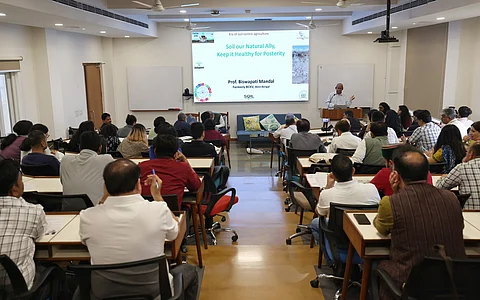

The health of India’s soils is at risk and there will be grave consequences of this unless immediate and concerted action is not taken, experts have said at the ongoing Anil Agarwal Dialogue 2025 in Nimli, Rajasthan
Biswapati Mandal, Professor, Bidhan Chandra Krishi Vishwavidyalaya, Kalyani and NK Lenka, Principal Scientist, ICAR-Indian Institute of Soil Science, Bhopal, offered new insight on the state of Indian soils at their session titled Is India losing its soils?
“Indian soil is one of the most vulnerable soils; average soil erosion in India is 20 tonnes per hectare per year against the global average of 2.4 tonnes per hectare per year,” said Mandal.
He added, “Our soil is losing its natural resilience — degraded lands can’t bounce back. It’s time for immediate, soil-centric action that empowers local governance and forges strong partnerships.”
There is a clear link between soil and human health, scientific research shows. As soil degrades, nutrients present in it vanish, leading to malnutrition among people.
In August 2023, researchers in the US published a study in the journal Scientific Reports, which for the first time conducts a large-scale evaluation of the relationship between the availability of micronutrients in the soil and nutritional status of people in India.
They found that districts where soil zinc availability was low had significantly higher rates of stunting (when a child has low height for their age) and underweight conditions (low weight per age).
They also found clear association between soil iron availability and anaemia.
According to Mandal, climate change is accelerating soil degradation, triggered by increased rainfall & acidity. The area of acidic soil is expected to increase by 40 million hectares in the future. Resilience of soil is reducing consequently.
Soil should be treated as global common on par with air, ocean and biodiversity, opined Mandal.
On his part, Lenka shed light on soil health of various states in India. “Nine of the 20 most susceptible districts of soil loss in India are in the state of Assam,” he pointed out.
Over 80 journalists from across the country are participating in the Anil Agarwal Dialogue, organised every year by CSE at its facility, the Anil Agarwal Environment Training Institute, located in Nimli, Rajasthan.